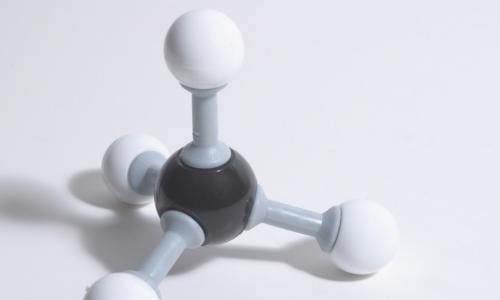Natural gas is a fossil fuel, like oil and coal, which releases pollution and global warming emissions when burned. Methane, the primary component of natural gas (or just "gas"), is itself a potent global warming pollutant, more than 80 times more powerful than carbon dioxide over a 20-year period.
Like oil, gas is a product of decomposed organic matter, typically from ancient marine microorganisms, deposited over the past 550 million years.
This organic material mixed with mud, silt, and sand on the sea floor, gradually becoming buried over time. Sealed off in an oxygen-free environment and exposed to increasing amounts of heat and pressure, the organic matter underwent a thermal breakdown process that converted it into hydrocarbons.
The lightest of these hydrocarbons exist in the gaseous state under normal conditions and are known collectively as natural gas. In its pure form, natural gas is a colorless, odorless gas composed primarily of methane. Methane, the simplest and lightest hydrocarbon, is a highly flammable compound consisting of one carbon atom surrounded by four hydrogen atoms (chemical formula: CH4).
Once methane gas forms, its fate depends on two critical characteristics of the surrounding rock: porosity and permeability. Porosity refers to the amount of empty space contained within the grains of a rock. Highly porous rocks, such as sandstones, typically have porosities of 5 percent to 25 percent, giving them large amounts of space to store fluids such as oil, water, and gas. Permeability is a measure of the degree to which the pore spaces in a rock are interconnected. A highly permeable rock will permit gas and liquids to flow easily through the rock, while a low-permeability rock will not allow fluids to pass through.
After gas forms, it will tend to rise towards the surface through pore spaces in the rock because of its low density compared to the surrounding rock. Most of the gas deposits we find today occur where the methane happened to migrate into a highly porous and permeable rock underneath an impervious cap rock layer, thus becoming trapped before it could reach the surface and escape into the atmosphere.
There are two general categories of natural gas deposits: conventional and unconventional. Conventional gas deposits are commonly found in association with oil reservoirs, with the gas either mixed with the oil or buoyantly floating on top, while unconventional deposits include sources like shale gas, tight gas sandstone, and coalbed methane.
US natural gas resources and reserves
The United States is endowed with substantial gas resources, and new discoveries and advances in drilling techniques have revised estimates of their size sharply upward in the past few years. In 2009, the US Energy Information Administration (EIA) estimated that the US possesses 2,203 trillion cubic feet of natural gas that could be recovered using current technology.
Conventional resources represent 46 percent (1,009 trillion cubic feet) of the total resource base, while the rest includes unconventional gas resources, such as tight gas, shale gas, and coalbed methane. Of the total US gas resource, 273 trillion cubic feet of gas are classified as “reserves,” which can be extracted under current economic and operational conditions [1].
As of 2012, the largest known gas reserves in the world are found in Russia, which has five times the reserves of the United States [2]. Iran and Qatar have four and three times as much gas as the U.S., respectively, and significant reserves are also present in Saudi Arabia, Turkmenistan, United Arab Emirates, Nigeria, and Venezuela. Total world reserves of natural gas are estimated at 6,707 trillion cubic feet [3].
Exploration and production of conventional gas resources
Potential methane deposits can be located with seismic testing methods similar to those used for petroleum exploration. In such tests, gas prospectors use seismic trucks or more advanced three-dimensional tools that involve setting off a series of small charges near the Earth’s surface to generate seismic waves thousands of feet below ground in underlying rock formations.
By measuring the travel times of these waves through the Earth at acoustic receivers known as "geophones," geophysicists can construct a picture of the subsurface structure and identify potential gas deposits. However, to verify whether the rock formation actually contains economically recoverable quantities of natural gas or other hydrocarbons, an exploratory well must be drilled.
Once the viability of a site is determined, vertical wells are drilled to penetrate the overlying impermeable cap rock and reach the reservoir. Natural buoyancy then brings the gas to the surface, where it can be processed and sent to homes.
[1] Energy Information Administration. 2012. Annual Energy Review. Table 4.1 Technically Recoverable Crude Oil and Natural Gas Resource Estimates, 2009.
[2, 3] Energy Information Administration. 2012. International Energy Statistics. Proved Reserves of Natural Gas.




